Suchergebnisse
Infoveranstaltung Wien (21.5.03)
In Informationsveranstaltungen werden Schwerpunkte und Ausschreibungsinhalte und Einreichmodalitäten vorgestellt. Für potenzielle EinreicherInnen besteht die Möglichkeit zu einem Beratungsgespräche.
Projektpräsentation: IMMO-RATE
Der Leitfaden für das Immobilienrating nachhaltiger Wohnbauten wird am 22. Juni in Wien und am 13. Juli in Bregenz vorgestellt. Der Termin am 29. Juni ist abgesagt.
Symposium: SESEC VI SYMPOSIUM
30. Oct 2007 - 1. Nov 2007
Olympic MuseumLausanne, CH
International Networking for Promoting Sustainable Development at the Local Level
Workshop: Advanced Fuel Cells
1. September 2010
University of Technology
Graz, AT
The main goals of the workshop are the presentation of the research´s main areas of the Implementing Agreement and the discussion about the current development status of fuel cell systems.
Konferenz: ökosan´15
17. - 19. Juni 2015
Messecongress GrazGraz, AT
6. internationale Konferenz für hochwertige energetische Sanierung und Nachverdichtung mit Holzbausystemen.
EASEY Online Ratingvorbereitung - Transfer
Aufbereitung und Übermittlung von theoretisch konzeptionellem Wissen über die Bewertung von nachhaltiger Entwicklung von KMU an drei finanzwirtschaftliche BeraterInnengruppen. Nachhaltiges Wirtschaften, so die These, trägt langfristig nachweisbar zur Verbesserung der Kreditrückzahlungsfähigkeit von KMU bei.
Neue Standards für alte Häuser - konkret
Zielgruppernorientierte, vernetzte Verbreitung des Sanierungsleitfadens "Neue Standards für alte Häuser" im Bau-und Baunebengewerbe sowie bei Bauherrn bzw. -frauen
Technology Platform Photovoltaic Austria
Between research institutions and the economic system the way has been paved to initiate joint R&D projects. Common research activities have been initiated and intensified to be able to position local companies in international niche markets for photovoltaics.
IEA EBC Annex 64: Optimierte kommunale Energiesysteme basierend auf Exergie-Prinzipien
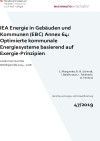
Die Optimierung städtischer Energiesysteme erfolgte im EBC Annex 64 mit Hilfe des Exergieansatzes: kaskadische Wärmenutzung, Integration von Wärmepumpen, Anwendung exergetischer Bewertungsmethoden auf Fallbeispiele. Als Ergebnisse werden Demonstrationsprojekte und Best Practice Beispiele erwartet sowie Gestaltungsrichtlinien für urbane Energiesysteme.
Schriftenreihe
47/2019
C. Marguerite, R.-R. Schmidt, I. Baldvinsson, I. Takahashi, O. Terreros
Herausgeber: BMVIT
Deutsch, 33 Seiten
Downloads zur Publikation
IEA Wärmepumpentechnologien (HPT) Annex 47: Wärmepumpen in Fernwärme- und -kälte-Systemen (Arbeitsperiode 2015 - 2019)
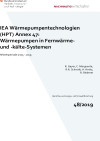
Eine signifikante Nutzung alternativer Wärmequellen mit Hilfe von Fernwärme- und Fernkältenetzen (FWK) ist eine wesentliche Herausforderung für eine nachhaltige Energieversorgung. In Zeiten steigender Anteile fluktuierender Erzeuger wie PV und Windenergie steigt die Relevanz von Wärmepumpen. Im Rahmen des IEA HPT Annex 47 wurden daher Potentiale und Barrieren zur Integration von Wärmepumpen in FWK-Netzen analysiert.
Schriftenreihe
48/2019
R. Geyer, C. Marguerite, R.R. Schmidt, A. Arnitz, R. Rieberer
Herausgeber: BMVIT
Deutsch, 38 Seiten
Downloads zur Publikation
„Stadt der Zukunft“ - Vernetzungstreffen
24. Oktober 2019
Wien
Das „Stadt der Zukunft“ Vernetzungstreffen diente der Vernetzung aller ProjektnehmerInnen der 6. Ausschreibung im Zuge des BMVIT Förderprogrammes „Stadt der Zukunft“.
IEA Bioenergy Task 42: Newsletter 2/2019

Schwerpunktthemen des Newsletters sind Neuigkeiten im Themenfeld Bioenergie sowie ein Rückblick auf den Alpine Bioeconomy Workshop, aktuelle Publikationen und ein Überblick über kommende Veranstaltungen.
Franziska Hesser, Johannes Lindorfer, Michael Mandl, Stefanie Wong
Herausgeber: IEA-Task 42, 2019
Deutsch, 4 Seiten
Downloads zur Publikation
IEA Photovoltaik (PVPS) Task 13: Ertragssicherheit und Zuverlässigkeit photovoltaischer Systeme
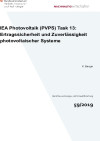
Ziel der Aktivitäten von IEA Task 13 ist die Stärkung der internationalen Zusammenarbeit zu Betrieb und Zuverlässigkeit von Photovoltaik-Anlagen. Die Plattform zum Austausch von Erfahrungen zu Qualität von PV-Anlagen und Komponenten ist ein Forum für unabhängige, internationale Analysen und Empfehlungen durch ExpertInnen und dient auch zur Verbreitung des Wissens unter den MarktteilnehmerInnen.
Schriftenreihe
59/2019
K. Berger
Herausgeber: BMVIT
Deutsch, 47 Seiten
Downloads zur Publikation
IEA Photovoltaik (PVPS) Task 15: Bauwerkintegrierte Photovoltaik
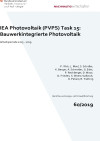
Bauwerksintegrierte Photovoltaik (BIPV) ist eines der Zukunftsfelder in der Photovoltaik, welches Energietechnik und Architektur zu einem Element zusammenführt. Das Projekt fokussierte sich auf zusätzliche nationale Forschung im Bereich der BIPV, um neue Geschäftsfelder zu identifizieren oder Ansätze zur internationalen BIPV Standardisierung zu entwickeln.
Schriftenreihe
60/2019
P. Illich, L. Maul, S. Schidler, K. Berger, A. Schneider, G. Eder, P. Rechberger, D. Moor, D. Frieden, S. Woess-Gallasch, G. Peharz, R. Trattnig
Herausgeber: BMVIT
Mehrsprachig, 75 Seiten
Downloads zur Publikation
IEA Windenergie Task 32: Wind-Lidar Systeme für den Einsatz in der Windenergie (Arbeitsperiode 2016 - 2019)
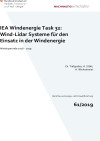
Der Task 32 der IEA Wind setzt sich seit dem Jahr 2012 mit der Weiterentwicklung und den vielfältigen Herausforderungen bei der Anwendung von LIDAR-Systemen (light detection and ranging) in der Windenergie auseinander. Die Ziele dieser internationalen Forschungskooperation sind das Zusammenstellen von vorhandenem Wissen und Erfahrungen sowie das Generieren neuer Erkenntnisse durch wechselseitigen Austausch und globale Vernetzung.
Schriftenreihe
61/2019
Ch. Tiefgraber, A. Stökl, H. Winkelmeier
Herausgeber: BMVIT
Deutsch, 33 Seiten
Downloads zur Publikation
IEA Energie in Gebäuden und Kommunen (EBC) Annex 67: Energie-flexible Gebäude (Arbeitsperiode 2015 - 2019)
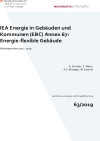
Das Projekt steigerte das Wissen über die Energie-Flexibilität von Gebäuden und die Potenziale, die ein Gebäude diesbezüglich den Energienetzen anbieten kann. Es werden entscheidende Aspekte aber auch mögliche Lösungen zur Nutzung von Energie-Flexibilität identifiziert und ein Bericht über die Prinzipien der Energie-Flexibilität von Gebäuden veröffentlicht.
Schriftenreihe
63/2019
A. Knotzer, T. Weiss, A.S. Metzger, W. Kastner
Herausgeber: BMVIT
Deutsch, 76 Seiten
Downloads zur Publikation
IEA EBC Annex 67: Newsletter 7, Juli 2019

Inhalte des Newsletters sind eine Rückschau auf das letzte Projekttreffen und einen öffentlichen Workshop in Aalborg/Dänemark, ein Artikel über die dänische Perspektive auf die Energieflexibilität, ein Artikel über das Flexibility-Evaluation-Tool (FET), den OPSYS-Teststand des DTI, ein Überblick über aktuelle Projekte in Dänemark und über Veranstaltungen für 2019-2021.
Søren Østergaard Jensen
Herausgeber: DTI, IEA-EBC Programm
Englisch, 9 Seiten
Downloads zur Publikation
IEA Windenergie Task 19: Windenergie in kalten Klimazonen (Arbeitsperiode 2016 - 2018)
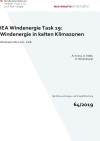
Der IEA Wind Task 19 befasst sich mit den Herausforderungen der Nutzung von Windenergie unter Vereisungsbedingungen und bietet durch globale Vernetzung und wechselseitigen Erfahrungsaustausch die Möglichkeit zur Sammlung und Generierung neuer Erkenntnisse. Schwerpunkte waren gemeinsame Aktivitäten mit den internationalen Partnern und die Standardisierung von Eisfallrisikogutachten. Ein Evaluierungsbericht zur Funktionstüchtigkeit der neuen Vestas Rotorblattheizung wurde erstellt.
Schriftenreihe
64/2019
A. Krenn, A. Stökl, H. Winkelmeier
Herausgeber: BMVIT
Deutsch, 35 Seiten
Downloads zur Publikation
IEA Wind TCP: Österreichischer Jahresbericht zu den Aktivitäten des IEA Wind Technologieprogramms (2020)

Der Jahresbericht fasst die wichtigsten Informationen zu den Aktivitäten der einzelnen Tasks des IEA Wind TCP zusammen.
Andreas Krenn
Herausgeber: Energiewerkstatt Verein
Deutsch, 19 Seiten
Downloads zur Publikation
Vertical Farming: Ermittlung der Anforderungsbedingungen zur Entwicklung eines Vertical Farm-Prototyps zur Kulturpflanzenproduktion
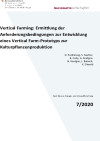
Im Mittelpunkt stand die Erforschung von Grundlagen für eine neue Gebäudetypologie, der Vertikalen Farm. Urbane vertikale Lebensmittelproduktion kann zur Steigerung der Energieeffizienz von und zur Reduktion des Landverbrauchs durch Städte beitragen. Wesentliche Einflussfaktoren zur Erreichung dieser Ziele werden durch diese Grundlagenforschung offen gelegt.
Schriftenreihe
7/2020
D. Podmirseg, S. Sautter, B. Cody, A. Keutgen, N. Keutgen, J. Balasch, K. Diwold
Herausgeber: BMK
Deutsch, 91 Seiten
